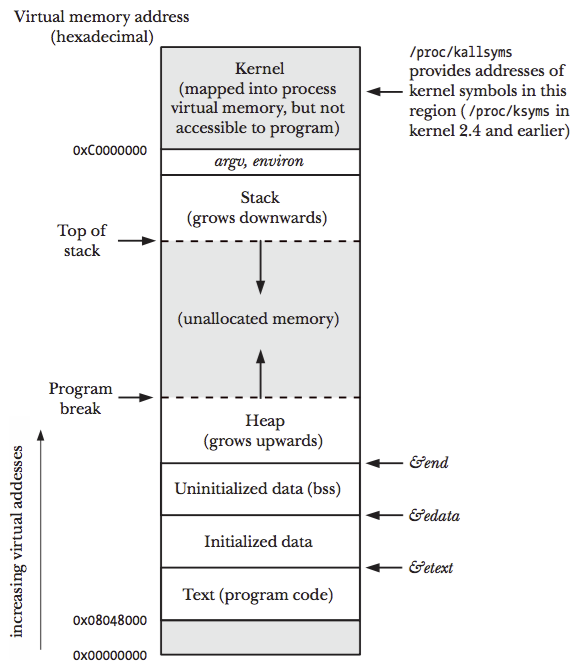
Chapter 7 of ?The Linux Programming Interface? is about memory allocation. One of the exercises, marked as advanced, asks the reader to implement malloc. I?ve decided to give it a shot. My full implementation is available on Github; I will try to break down some of my reasoning on the next sections and include some snippets from the code.
Memory layout of a Process
The memory allocated to each process is composed of multiple segments, as can be seen on the following image:
 Source: https://github.com/shichao-an/notes/blob/master/docs/tlpi/figure_6-1.png
Source: https://github.com/shichao-an/notes/blob/master/docs/tlpi/figure_6-1.png
We are particularly interested on the heap (also known as the data segment), an area from which memory can be dynamically allocated at run time. The top end of the heap is called the program break.
Adjusting the program break
We can move the program break on our C program by using sbrk() and brk().
int brk(void *addr);void *sbrk(intptr_t increment);
The first, moves the program break to the address pointed by addr, while the latter increments the program break by increment bytes. Their man pages can give more information about their implementation on Linux and other systems, but those are the basic building blocks that our malloc implementation will rely on. On Linux, sbrk relies on brk.
The implementation
The entire code for the implementation is available at github. Beware that this implementation is full of bugs (some are discussed below, some are obvious from reading the real malloc implementation). The following code is the malloc function implementation.
Our implementation keeps a doubly linked listed of free memory blocks and every time _malloc gets called, we traverse the linked list looking for a block with at least the size requested by the user (lines 8?25). If a block with the exact requested size exists, we remove it from the list and return its address to the user (lines 11?16); if the block is larger, we split it into two blocks, return the one with the requested size to the user and adds the newly created block to the list (lines 19?21).
If we are unable to find a block on the list, we must ?ask? the OS for more memory, by using the sbrk function (lines 31?35). To reduce the number of calls to sbrk, we alloc a fixed number of bytes that is a multiple of the memory page size, defined as:
#define ALLOC_UNIT 3 * sysconf(_SC_PAGESIZE)
After the call to sbrk (where our program break changes value) we create a new block with the allocated size. The metadata on this block contains the size, next and previous blocks and is allocated on the first 24 bytes of the block (this is our overhead) (lines 36?38). Since we may have allocated much more memory then the user requested, we split this new block and return the one with the exact same size as requested (lines 39?43).
The BLOCK_MEM macro, defined as:
#define BLOCK_MEM(ptr) ((void *)((unsigned long)ptr + sizeof(block_t)))
returns skips the metadata at given ptr and returns the address of the memory area that is available for the user.
The _free function is quite straightforward, given a pointer that was previously ?malloced? to the user, we must find its metadata (by using the BLOCK_HEADER macro) and add it to our free linked list. After that, the function scan_merge() is called to do some cleaning:
scan_merge() first traverses the linked list looking for continuous blocks (two different memory blocks that are free and correspond to continuous addresses). We keep the blocks sorted by address to make this step easier. For every two continuous blocks found, we merge both blocks to reduce our total overhead (less metadata to keep) (lines 18?33).
After finding the last block on our free list, we check if this blocks ends on the program break (line 39). If that is true, and the block is big enough (where ?big? is defined as MIN_DEALLOC, also a multiple of the page size), we remove the block from our list and move the program break to the beginning of the block, by calling brk.
How is malloc actually implemented?
Before diving into the real malloc code, I decided to write a simple test program and trace it?s execution using strace. I used the following code:
I decided to trace the executing testing different sizes.
$ strace ./malloc 1…brk(NULL) = 0x5585209f2000brk(0x558520a13000) = 0x558520a13000exit_group(0) = ?+++ exited with 0 +++$ strace ./malloc 100000…brk(NULL) = 0x55b45a386000brk(0x55b45a3bf000) = 0x55b45a3bf000exit_group(0) = ?$ strace ./malloc 1000000…mmap(NULL, 1003520, PROT_READ|PROT_WRITE, MAP_PRIVATE|MAP_ANONYMOUS, -1, 0) = 0x7f05f7cbf000exit_group(0) = ?
The first thing I noticed between executions is that when asking for a large size, malloc actually used mmap instead of brk to allocate the memory. I wasn?t sure why, since I have yet to study mmap. But checking the code for glibc?s malloc I?ve found a pretty nice writeup made by the authors explaining their implementation. I highly recommend reading it. Regarding the use of mmap, from the source code comments:
This backup strategy generally applies only when systems have “holes” in address space, so sbrk cannot perform contiguous expansion, but there is still space available on system. On systems for which this is known to be useful (i.e. most linux kernels), this occurs only when programs allocate huge amounts of memory. Between this, and the fact that mmap regions tend to be limited, the size should be large, to avoid too many mmap calls and thus avoid running out of kernel resources.
The documentation also explains their design goals, motivations, how the blocks are organized (by using bins for the different sizes, instead of keeping a linked list sorted by address, as I did) and lots of other details. I learned a lot reading it.
Adding a call to free on my test program does not change the syscalls made by at, as the memory is not released to the OS (some people rely on this behavior ?mallocing? a large chunk of memory and freeing it on the start of a program to reserve the memory). One can control this behavior by defining M_TRIM_THREASHOLD:
M_TRIM_THRESHOLD is the maximum amount of unused top-most memory to keep before releasing via malloc_trim in free(). Automatic trimming is mainly useful in long-lived programs. Because trimming via sbrk can be slow on some systems, and can sometimes be wasteful (in cases where programs immediately afterward allocate more large chunks) the value should be high enough so that your overall system performance would improve by releasing this much memory.
This blog post is part of a series of posts that I intent to write while reading ?The Linux Programming Interface? to make sure I?m actually learning something, as a way to practice and to share knowledge.


